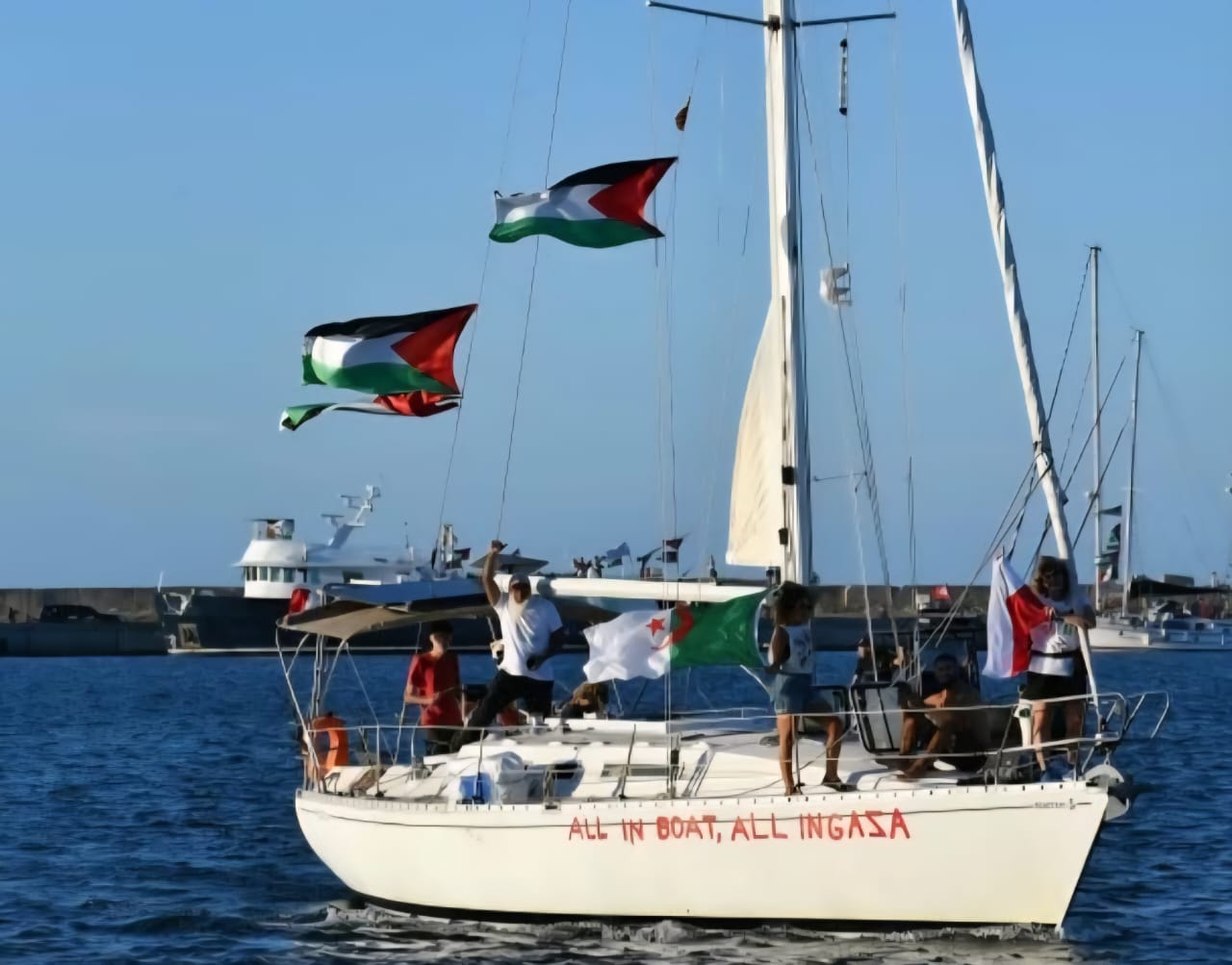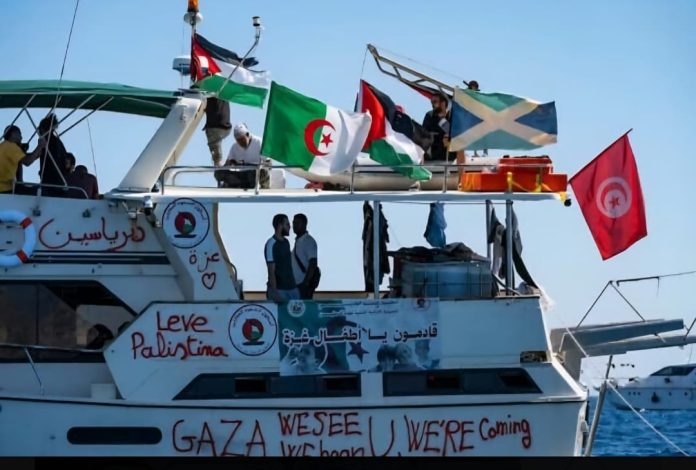
By Brig Syed Karrar Retired
In late September–early October 2025 a large international convoy of civilian boats — calling itself the Global Sumud (Steadfast) Flotilla — set sail for the Gaza Strip with the stated aim of delivering symbolic humanitarian supplies and breaking or drawing attention to Israel’s naval restrictions on Gaza. The operation brought together parliamentarians, labour activists, lawyers, humanitarian campaigners, journalists and well-known public figures from several countries. The mission rekindled a long and painful chapter in Mediterranean politics: previous attempts to challenge the blockade of Gaza have repeatedly produced diplomatic crises and, in 2010, deadly confrontations. The Global Sumud Flotilla therefore combined practical aid with political theatre — and with that mix came significant danger.
Who organised the flotilla — and who joined it
The flotilla was organised under the banner “Global Sumud” — sumud meaning “steadfastness” in Arabic — by an international alliance of pro-Palestine groups and civil society organisations. Organisers said the fleet comprised more than forty small civilian vessels carrying roughly five hundred participants, a mix of elected officials, legal experts, union members, aid volunteers and prominent activists who wanted to spotlight Gaza’s humanitarian crisis and protest the maritime restrictions. Several nationalities and well-known international figures were reported among the passengers; media images and official statements confirmed that high-profile climate and human-rights campaigners were aboard some vessels. Organisers stressed that the cargo was mainly symbolic — essential medicines and food parcels intended to underline the humanitarian argument — while the primary objective was to register a political and moral protest against what they describe as an effective siege of Gaza.
Why people arranged the flotilla
There are three intertwined motives behind the Sumud Flotilla:
1. Humanitarian solidarity. Activists framed the mission as an act of solidarity with civilians in Gaza and as a way to draw attention to shortages of medicines, fuel and reconstruction materials in the aftermath of prolonged conflict. While the amount of cargo per vessel was modest, organisers argued the symbolic act of delivering aid by sea challenged the reality of restrictions that, they say, make life in Gaza untenable.
2. Political protest and legal challenge. The flotilla sought to contest the legality and morality of a naval blockade that international critics contend imposes collective hardships on Gaza’s population. By deliberately attempting to approach Gaza by sea, the activists aimed to provoke a legal and diplomatic response that would bring the issue before international bodies, courts and public opinion.
3. Public visibility. Large, media-friendly flotillas have a history of generating global headlines — a tactical advantage for groups seeking to mobilise public outrage and to press governments to act. For many participants, the voyage was as much about creating pressure through visibility as about delivering supplies.
Risks and difficulties the participants faced

Sailing into a contested maritime area is inherently risky. The Sumud Flotilla encountered multiple practical, legal and safety challenges:
Naval interception and use of force. The Israeli navy intercepted a large number of vessels in international waters, boarding many of them and diverting them to Israeli ports. Boarding operations at sea are dangerous: they can involve fast approach boats, grappling, use of non-lethal measures (water cannons, stun grenades) and, in the worst scenarios, close-quarters confrontations that risk injury or worse. News reports and live footage showed naval units approaching and boarding vessels, and activists described stun grenades and water cannon being used during the operations.
Maritime hazards. Small civilian boats are vulnerable to heavy weather, engine failure and collisions. A long voyage across the Mediterranean — often under pressure from military vessels — increases the likelihood of mechanical or medical emergencies far from shore. Organisers had to manage logistics (fuel, navigation, medical kits) while under the stress of interception risk.
Detention and legal uncertainty. Activists understood there was a strong chance of detention, deportation or prosecution if intercepted. Being taken to a foreign port removes participants from home-country consular reach for a period and can expose them to legal processes they had not planned for. For some nationalities this led to immediate diplomatic engagements; for others the consequences included temporary incarceration and administrative procedures.
Political backlash at home. Participants — especially elected officials — risked political repercussions in their own countries. Governments sympathetic to Israel or worried about diplomatic fallout had to balance citizen safety with foreign-policy considerations, and some states publicly condemned the flotilla while others expressed concern for their nationals.
Security and escalation risk. Given the history of past flotillas (notably the deadly 2010 Mavi Marmara raid), organisers and participants had to weigh the possibility of a violent escalation. Even if both sides attempted to avoid bloodshed, accidents or miscalculations during a boarding could produce casualties and a major international incident. Media coverage repeatedly reminded the public of that precedent.
Why Israel intercepted and arrested people on the flotilla.
Israeli government do not want that humanitarian assistance like food, medicine and clothing etc reach to dying people of Ghaza. However, they give lame excuses for not allowing fittela to Ghaza which are,
The flotilla posed multiple security and legal problems. The Israeli government and military defended the interceptions with several claims and legal arguments:
1. Security risk and intelligence concerns. Israeli authorities often argue that unvetted civilian vessels approaching a conflict zone present security risks, including the possible smuggling of weaponry or the use of vessels for asymmetric attacks. Even if the flotilla’s declared cargo was small, Israel has said it must inspect and secure the vessels before any transfer of supplies to Gaza can occur through controlled channels.
2.Prevention of escalation inside Gaza. Israel has maintained that it prefers aid to be transferred through established, supervised channels — land crossings controlled by Israeli and international monitors — to ensure that humanitarian supplies reach civilians and not militias. From this viewpoint, an unsanctioned maritime delivery could bypass safeguards and complicate military operations or reconstruction planning.
3.Public order and deterrence. Israel also framed the flotilla as a political provocation designed to inflame tensions and to generate publicity for supporters of Hamas. Stopping the flotilla, officials argued, was therefore part of preventing a politically useful win for enemies and their international backers.
The immediate and wider consequences
The interception and detention of activists led to immediate diplomatic friction: a number of countries summoned Israeli envoys, some announced expulsions or other punitive measures, and public demonstrations erupted in major cities. Trade union actions and organised strikes were called in solidarity in some European cities, reflecting the high public profile of several detained figures. The episode also revived the legal and moral debates about the Gaza blockade that have run through international diplomacy since 2007.
Conclusion — symbolism, law and the costs of protest at sea
The Global Sumud Flotilla highlighted the potent mix of symbolism, law and risk inherent in maritime protest. For organisers and participants the voyage was a moral statement: an attempt to keep international attention focused on Gaza and to test the limits of what activists and foreign parliaments can do to press for humanitarian relief. For Israel, the same act represented a security threat and a challenge to state control of aid flows to a war-torn territory. The interception, detentions and diplomatic fallout show how easily an act intended as peaceful solidarity can become an international incident when it collides with contested security policies and an unresolved legal framework.
Whatever one’s political stance, the human element is unavoidable: ordinary people — activists, volunteers, elected representatives — put themselves at sea, knowingly exposed to detention, danger and the risk of being used as instruments in a larger geopolitical dispute. The Sumud Flotilla therefore remains both a humanitarian statement and a reminder that maritime protest in a conflict zone is an arena where moral gestures, legal claims and military calculations intersect — often with unpredictable and far-reaching consequences.

























